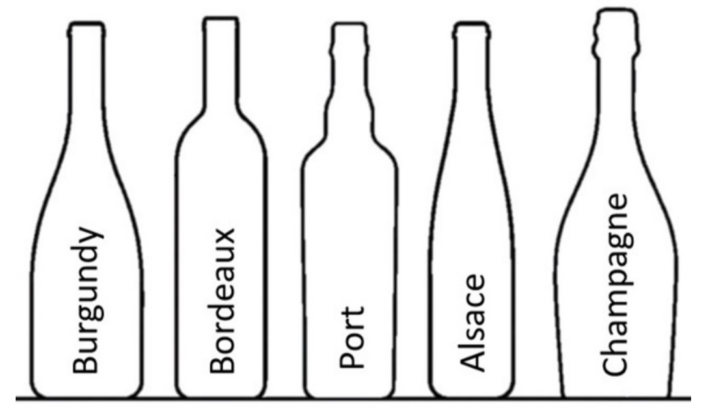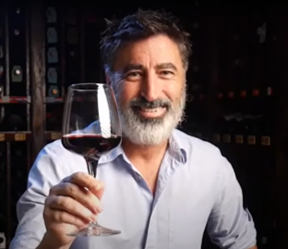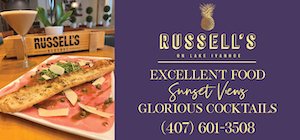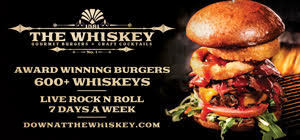

Have you ever wondered why wine bottles come in different shapes? Perhaps you have even heard their associated names, most of them French. The Bordeaux bottle, the Burgundian, the Alsatian. Actually, there is a reason behind each bottle shape and name, though not always associated to a functionality.
It all started in Burgundy, France, in the 19th century, where winemakers decided to use bottles with graceful, sloping shoulders. Interestingly, that was a thoughtful marketing decision designed to provide a recognizable visual packaging style to Burgundian wines, precisely when they had started gaining ample recognition by the international community. But that was an easy adoption as well, as such smooth bottle shapes were easier to fabricate. A win-win situation.

Bordeaux winemakers quickly followed the trend, always looking above each other shoulders as the two dominant top-quality wine production areas in the world, and came up with the Bordeaux bottle, which presents sharper shoulders. Whether or not the adoption of this shape was to visually differentiate their products from Burgundian wines, the fact is that its sharp shoulder helps catch the wine’s solid sediments while serving, which turns out particularly important for Bordeaux wines as they contain higher levels of sediment at the bottom of the bottle. Having a sharp shoulder helps keep the sediments in the bottle when pouring the last drops of wine. Serendipitously, a marketing decision that becomes functional.
Actually, the Port bottle, with a similar shoulder to the Bordeaux, purposely adds a small extra dent in the neck to further assist capturing those wine sediments. These are substantially more present in the unfiltered fortified wines made in the Portuguese town of Vila Nova de Gaia, right across the Douro River from Porto, from grapes grown further east up the river. Interestingly, this bottle shape obeys a functional purpose, rather than aesthetic, while still becoming a recognizable packaging of Port wines. This time, a functional decision that becomes marketable.
Without any doubt, the most refined wine container is the Alsatian bottle. Substantially more elongated and elegant, it resulted from the need to pack the maximum number of bottles in the small boats used to transport the wines through the Rhine River. This bottle shape is strongly associated with the wines made from the main grapes found in Alsace, such as Riesling and Gewürztraminer, and is also widely found in the most famous elaboration areas in Germany, some of them located along the Rhine banks, like Rheingau, Reinhessen, or Franken, or one of its famous tributaries, such as the Mosel and Nahe rivers, also famous wine regions on their own. This should not come as a surprise considering that the Alsace region has alternated French and German nationalities several times over the years, becoming permanently French at the end of the Second World War. Again, this functional solution to improve the packing of bottles for commercial purposes has become an identity sign for Riesling and Gewürztraminer wines all around the world.
Finally, a special mention goes to the Champagne bottle. We all know that sparkling wine bottles are heavier and thicker. The reason goes back to France again, as stronger glass containers were necessary to uphold the high pressure (5-6 atmospheres) built from the second fermentation of the wine inside the bottle. The high latitude of the Champagne region makes the climate particularly cold. Temperatures drop so much during the winter months that fermentation stopped before all the sugar was consumed by the yeast (Champagne wines were traditionally sweet). That would not present a major problem if fermentation did not decide to restart with temperature rising in the Spring when many bottles were on their way to the consumer, particularly to the British market. The built-in pressure made many bottles explode during transportation, causing severe financial losses. Interestingly, a new taste for fizzy and sparkling wines, particularly by British consumers of bottles that had not exploded, resulted in a quickly growing demand for sparkling wines.
Long-history-short, new bottle-making techniques developed in modern glass factories in Britain provided the solution to satisfy the new demand. Actually, not only the thickness of the bottle is larger than in regular wine bottles, but the base of these bottles has a pronounced protrusion that bends inside the bottle, engineered to minimize the effect of pressure on the fragile glass. Indeed, a physics rule of thumb when it comes to pressurized containers is that you want to avoid flat areas, as the pressure adds up to generate a stronger force pushing on the glass from the inside. But this is not modern physics. Romans knew about it well in advance. Think about the Roman amphorae! Champagne bottles obey the same principle.

Actually, there is one very recognized and historical producer of sparkling Cava wines in the Penedès region of Spain that bottles what many consider the best Cava in the world in a glass container in the shape of a Roman amphora. Simply put, reversing the base of a Champagne bottle inside-out results in an amphora. Watch the winemaker and family owner of Agustí Torrelló Mata talk about Kripta, as this Cava is called.
Navigate through our selection of wines in The Winedos Store. We have bottle shapes of all kinds for you to try (the insides).










